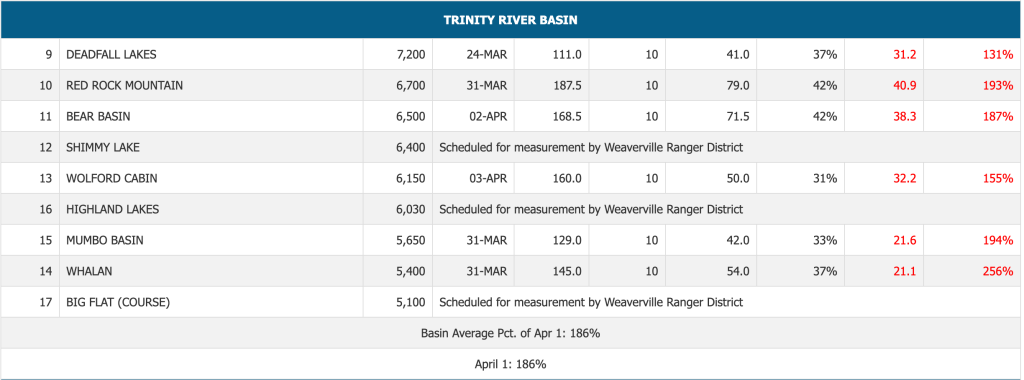Comments before the State Water Resources Control Board
Sari Sommarstom, PhD
4/4/23
*updated Charts From


Hello, my name is Dr. Sari Sommarstrom; I’m a retired watershed consultant who has worked in the Scott River watershed for over 30 years.
The Scott River Watershed, a sub-basin of the Klamath Basin, is not currently experiencing drought conditions, as recent hydrologic data will show. This finding is an update–and in contrast–to the Governor’s recent rollback of drought restrictions that excluded the Klamath for being persistently dry. The Scott River watershed and most of the Klamath Basin were categorized as D1- Moderate Drought in last week’s US Drought Monitor, which stated that “drought removal is likely over the next month” for this area. While the Sacramento River Basin is also in the D1 category, that region was included in the Governor’s rollback. This policy inconsistency is not justified by the data.

While many atmospheric river storm events have hit much of California to the south this winter, the Klamath has been on the edge of most of those extreme events. This region is not having a Wet Water Year but is moving into an Above Average Water Year. This improvement in hydrologic conditions should be recognized by the State Water Board, especially regarding its Emergency Drought Regulations currently in place and subject for renewal by July.
Much of the precipitation during the past 3 months has been in the form of snow. Continuing cold weather has kept the snow base intact with succeeding storms adding to the base.

Too much snow prevented the March 1st Snow Survey by the US Forest Service from taking place for the Scott River Watershed except for 1 of their 5 sites. Their April 1 snow survey is underway, with 2 sites reported so far, indicating a 151% average Snow Water Content. Special snowmobiles are needed to access the remaining sites, something they’ve not needed to use in many years, to indicate the unusual amount of snow. For the Trinity watershed, so far the April 1 survey for 1 of 6 sites shows 131% snow water content, and Shasta watershed (all 3 sites) shows 162%.
Upper Klamath Basin’s latest snow measurement in Oregon indicates 165%.
Most of this Above Average stored snow water content in the upper watersheds will contribute to runoff into the streams during the upcoming spring and summer months, a far better condition than this region has had for the past 3 years. Current flows fluctuate below the Median and do not yet reflect the amount of water stored in the snowpack.

Rainfall in Scott Valley is also above average, between 102 and 153% to date. It’s important to note that the Scott Valley aquifer is not overdrafted, as confirmed by UC Davis studies using decades of data. And there is no land subsidence here.
Groundwater Recharge is happening naturally to some extent in our aquifer with this precipitation, but Scott Valley’s Groundwater Sustainability Plan, with UCD research guidance, is seeking to accelerate recharge through a unique effort of Environmental Managed Aquifer Recharge, or something we’re calling Enviro-MAR. Its purpose is not to refill an overdrafted aquifer, unlike what’s happening with Flood-MAR in many areas of the state right now. Instead, its intent is to fill the aquifer even more through a small amounts of river diversion to create field flooding in the winter which will elevate groundwater storage for eventual discharge of cool water into the Scott River in late summer to early fall. This low flow time period can limit habitat access by salmon and steelhead, so borrowing winter water to benefit late season flow is an environmental benefit. Support for this unique effort by the Board for a proposed 5-year permit will allow the needed research to help fine tune this very important water management tool for our undammed river system. For example, the current recharge permit allows up to 30 cfs for a period of 90 days to create a potential added volume to 5,400 acre-feet. However, unreasonably high flow requirements on this permit have prevented significant implementation this year despite the good watershed conditions. Scott Valley has most of the needed infrastructure to implement recharge efforts well, if just given the chance.
Groundwater levels have come up this winter, with the effects of the wetter conditions not yet showing up due to the lag time effect.
Please update the Water Board’s description and understanding of the current hydrologic conditions of the Scott River watershed as new information, such as the above, becomes available. It is not reasonable to treat this area as being in serious drought at this point. Sadly, the State’s credibility will be seriously questioned if this drought designation continues along with the inequitable treatment of Scott Valley’s water users, as testified this morning by AgWA’s Theodora Johnson.
SWB staff has been in better communication with the local community this past year, and that’s a good thing. But more dialogue and site visits are needed to create a mutual understanding of local hydrology, water rights, and water management practices.
For more information and articles check out Scott Valley Agriculture Water Alliance
- EPA conducted Rotenone experiments on Klamath Basin?
- The Klamath River September 2002 Fish Die-off : Older Fish from Trinity River Hatchery Affected
- Where did the Sockeye Go From The Klamath ?? Will they return without the dams ?
- 10 Times as Much of This Toxic Pesticide Could End Up on Your Tomatoes and Celery Under a New EPA Proposal
- the Obituary of James Lipke




